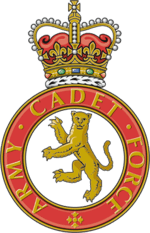Army Cadet Force
| Army Cadet Force (ACF) | |
|---|---|
|
Crest | |
| Founded | 1859[1] |
| Country | United Kingdom |
| Role | Volunteer Youth Organisation British Army |
| Size |
41,370 Cadets[2] 9,170 Cadet Force Adult Volunteers[2] |
| Headquarters | CTC Frimley Park |
| Motto(s) | To Inspire To Achieve |
| Website | armycadets.com |
| Commanders | |
| GOC Support Command | Maj Gen Richard Stanford MBE |
| Patron | Queen Elizabeth II[1] |
| Colonel in Chief | HRH The Duke of Edinburgh[1] |
The Army Cadet Force (ACF) is a national youth organisation sponsored by the United Kingdom's Ministry of Defence and the British Army. Along with the Sea Cadet Corps and the Air Training Corps, the ACF make up the Community Cadet Forces. It is a separate organisation from the Combined Cadet Force which provides similar training within principally independent private schools.
Although sponsored by the Ministry of Defence, the ACF is not part of the British Army or Army Reserve, and as such cadets are not subject to military 'call up'. Some cadets do, however, go on to enlist in the armed forces in later life, and many of the organisation's leaders have been cadets or have a military background.
The Army Cadet Force Association (ACFA) is a registered charity that acts in an advisory role to the Ministry of Defence and other Government bodies on matters connected with the ACF.[3][4] The Army Cadet Force is also a member of The National Council for Voluntary Youth Services (NCVYS), as an organisation with a voluntary and community youth focus.[5]
As of 1 April 2015 there are 50,540 Cadets and Cadet Force Adult Volunteers.[2]
History
In 1859 local Militia units (predecessors of the Territorial Army), were organised into a nationwide Volunteer Reserve Force because of the threat of French invasion. The first unit of the ACF to be formed was the Robin Hood Rifles formed by Mrs Octavia Hill on Frimley Park in 1859. These new Volunteer units formed Cadet Companies and eight public schools formed independent cadet units (fore-runners of the Combined Cadet Force). The late Victorian period was when the time of social change began to take hold in Britain and a Mr Adam Gray who was considered to be a pioneer in Social Work founded Independent Cadet Corps units. The formation of Cadet units also spread to the colonies. The Bermuda Cadet Corps was formed at the turn of the Century with detachments in the schools of the British Army's Bermuda Garrison and the Royal Navy's dockyard, as well as a handful of civilian schools. It's cadets wore the cap badge of the Bermuda Volunteer Rifle Corps, to which the Bermuda Cadet Corps was attached.
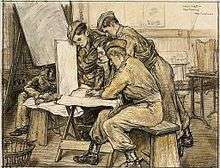
In 1908 when the Territorial Army was formed both the Volunteer and Independent Cadet Companies came under the control of the Territorial Forces Association, whilst the Public School units were part of the Officer Training Corps. In 1914 all independent Cadet units were taken under control by the War Office and the name Army Cadet Force was born.[6]
During the war, the War Office extended the earning of Certificate "A", which with Certificate B, had been used by the OTCs (Officer Training Corps), to the Cadets. This became the goal for most cadets until the APC tests were introduced. The tests covered many aspects of infantry training, including drill, map reading, weapon training and shooting, fieldcraft (also known as Battle-drill), fitness, and command instruction.
The award of the certificate permitted the holder to have a four-pointed star on the lower sleeve The star was red with khaki edgings. A technical certificate (Certificate T) was also developed, in 1943, covering engineering knowledge. The award of this gave another four-pointed star, but with the centre in blue. The holder of a Certificate T was assured the entry into one of the technical corps (RE, RAOC, or REME) on being called-up. The Certificate A holder was given a shorter training period.
In 1923 as a result of Defence cutbacks all Governmental and Military support for the ACF was withdrawn. This led to the forming of the British National Cadet Association (BNCA) by notable figures such as Lord Allenby who were keen to maintain the ACF and lobby for Government funding, this was partially successful in during the 1930s. From 1939 the Cadet Forces supported the Home Guard at a time when the threat of German invasion was very real, because of this in 1942 the ACF was re-formed.
Following a Government review of the Armed Forces in 1957 the ACF assumed its role of a national youth organisation sponsored by the Ministry of Defence (MoD).
Prior to the 1982 females were unable to join the ACF, although they were able to join an attached unit (if there was one at that location) of the Girls Venture Corps which had been formed in the early years of the Second World War
Structure and organisation
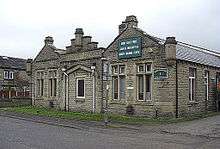
Most British counties have centralised cadet forces that make up the ACF as a national whole. The counties are generally split into companies, each of which includes several detachments, the name given to a unit of cadets that parade in a particular town or village. Some battalions or Counties are affiliated with a certain Regiment or Corps within the British Army, and wear their insignia including cap badge, colour of beret and stable belt subject to individual County/Area regulations. In other battalions or counties each detachment is individually affiliated to a Regiment or Corps within the British Army. Detachments are usually called by the name of the place in which they are based or those attached to schools may use the name of the school.
Locations
Cadet Force Adult Volunteers
Adults may join the ACF to instruct through two different routes - as an Adult Instructor (AI) or as a Commissioned Officer.
Adult Instructors
Prospective Adult Instructors begin as a Civilian Assistant (CA) before passing a medical and an enhanced disclosure. After completing the Familiarization and Assessment weekend (F&A) and Basic Induction Course (BIC), which takes place over 4 weekends at county level, they then become a Probationary Instructor (PI). As a PI, adults then go on to complete the Intermediate Instructors Course (IIC) at county level held over 3 weekends and the Advanced Instructors Course (AIC) held over one week at brigade level and run by a Cadet Training Team (CTT). On successful completion of this course they will be appointed to the rank of Sergeant Instructor (SI). Progressive training takes place for Adult Instructors, as with cadets, an Adult Instructor may take part in a variety of different courses.An example of a further course which takes place at CTC Frimley Park is the Adult Leadership and Management Course.[7] On successful completion of a course like this which demonstrates characteristics like the ability to plan and manage training an AI is eligible for promotion to the rank of Staff Sergeant Instructor (SSI). The Exercise Conducting Officer's (ECO) and optional Cadet Drill instructor Course (CADIC) are the final courses for AIs and the further ranks of Sergeant Major Instructor (SMI) and Regimental Sergeant Major Instructor (RSMI) are possible.[8] Adult Instructors will be expected to work in a team with their superiors and senior cadets they are responsible for, to deliver effective training to the cadets.
Officers
The other route a CFAV in the ACF may take is that of becoming a commissioned officer. The CFAV will apply and partake in the same selection process as above, however once a Probationary Instructor, the individual may apply or be nominated to become a commissioned officer. To do so, as of 2006, the individual must then attend a Cadet Forces Commissions Board (CFCB), similar to an Army Officer Selection Board though less physically demanding. The applicant will be assessed on their literacy, problem solving, and leadership ability. Successful applicants will then be appointed to a TA Group B Commission in Her Majesty's Land Forces, making them a non-deployable Officer. Commissioned Officers in the ACF will hold senior leadership roles with more responsibility and commitment attached than roles occupied by Adult Instructors, for example detachment commander or within their Company HQs.
Staff costs
The Cadet Force is one of the few voluntary organisations that pays its adult voluntary staff for their time. These staff can receive up to 28 days pay per year, they also receive subsistence and travel expenses for attendance on evenings, weekends and annual camps. In 2009/10 pay bill for ACF part-time staff was £14,632,160 and their expenses totalled £368,349.[9] The cost of full-time staff was estimated at around a further £6,250,000 of public funds.
Activities
Army Proficiency Certificate
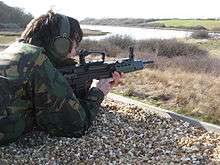
The Army Proficiency Certificate (APC) is the training syllabus of the ACF and is divided into five levels each covering the core subjects but in more detail as they progress.
- Basic/Recruit (introductory training)[10]
- 1 Star (cadets learn the rudiments of each subject)[11]
- 2 Star (cadets learn each subject in more depth)[12]
- 3 Star (cadets master each subject)[13]
- 4 Star (complete two progressive subjects or courses)
- Master Cadet (cadets must successfully complete the Master Cadet Course held at CTC Frimley following a recommendation from their Cadet Commandant)
Core subjects
- Drill and Turnout
- Military Knowledge
- Fieldcraft
- Skill at Arms
- Shooting
- Navigation
- Expedition Training
- First Aid
- Physical Training
- Cadet And Community
Drill & Turnout
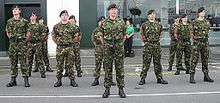
Cadets are taught a subset of the drill movements taught to the regular army.[14] They begin by learning basic foot drill and progress to learn rifle drill and banner drill. They are also taught how to wear and take care of their issued uniform.[11]
Fieldcraft
In fieldcraft lessons, cadets learn infantry skills such as patrolling, section battle drills, ambush drills, harbour drills, and how to survive in the field.[15] Field exercises take place once every few months, and at annual camp. On exercise, cadets wear Multi-Terrain Pattern camouflage clothing, camouflage cream to eliminate the face's natural shine, a bush hat and foliage to break up the shape of the head and shoulders, a Cadet Training Vest or PLCE webbing to carry rifle magazines, water bottles and emergency rations, and a bergen to carry a sleeping bag and basha (improvised shelter) building materials. Cadets are issued with 24-hour ration packs (or known as rat packs to cadets) and dragon fire cookers as used by the infantry. As part of a platoon, cadets set up harbour areas (operations bases), post sentries, and send out patrols to carry out reconnaissance, lay ambushes, and assault enemy positions. Cadets become familiar with hand signals for silent communication, and patrol formations for crossing different types of terrain. Scaled down versions of these expeditions are regularly held at a local detachments.
Skill at Arms
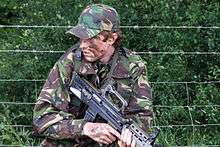
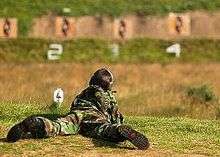
The L98A2 Cadet GP Rifle[16] is a version of the British Armed Forces' L85A2 (both part of the SA80 family of weapons) adapted to fire only on a semi-automatic setting. In order to become proficient on the weapon and pass the one-star Skill at Arms (SAA) test, cadets must show they can handle the weapon safely, perform stoppage drills, and field strip the weapon for daily cleaning.[17] Once this has been done, cadets can fire the weapon using blank rounds in field exercises and with live rounds on a range possibly gaining marksman qualification badges based on their accuracy. There is also a deactivated version of the GP Rifle, the L103A2 DP (Drill Purpose), this is generally used for teaching cadets the basics of the weapon they are handling and for rifle drill. Cadets also learn to handle and fire the Rifle No 8 .22 calibre rifle on a 25 m rifle range.
Many cadet forces have also adopted .22 calibre "conversion kits". These kits allow the 5.56mm L98A2 rifle to fire .22 calibre bullets, as many .22 calibre rifles are no longer in working condition. Senior Cadets who have passed two-star Skill at Arms are introduced to the L86A2 Light Support Weapon which, unlike the GP, can fire in fully automatic mode. With its longer barrel and bipod, the L86A2 has a greater range and muzzle velocity, and with its SUSAT (Sight Unit Small Arms Trilux - the optical sight on top of the weapon), it allows for greater accuracy. Cadets who prove they are of above average shooting level may be offered a chance to fire the L81A2.
Cadets can enter various shooting competitions, including the ACF Cadet 100 .22 Rifle Competition and the CCRS Country Life (Green Howards) Small-bore .22 Rifle Competition.[18]
Navigation
Cadets learn how to navigate using a map and compass. Cadets learn to use Ordnance Survey maps plot and find six-figure grid references, calculate distances between points, and to recognise various conventional signs. The two-star map and compass course then introduces cadets to the Silva (Expedition 4) and Suunto (M-5N) lightweight protractor compasses. Cadets learn to use and plot grid and magnetic bearings to understand the three different types of north, to account for deviation of the grid-magnetic angle, to understand contour lines and more advanced conventional signs and the preparation of route cards. Once cadets are experienced in Map and Compass, they are taught how to lead expeditions, which also included their knowledge of fieldcraft.
First aid
As part of the training syllabus Cadets are taught First Aid to recognised standards and are awarded relevant certificates.[19] The syllabus is broadly based on the St John Ambulance Activity First Aid syllabus, working at the following levels.
- Basic complete the British Heart Foundation "Heartstart" course [20] and learn basic incident management.
- One Star Cadets build on the knowledge gained at basic level and learn how to deal with other minor injuries.
- Two Star Cadets are required to complete the St John Ambulance Youth First Aid certificate Course
- Three Star Cadets have to complete the first day of the St John Ambulance Activity First Aid Certificate Course
- Four Star Cadets may choose to complete first aid as one of their progressive subjects. This includes passing the full Activity First Aid Course[21] and completing practical work within their county such as training other cadets for APC awards or competitions.
Cadet and the community
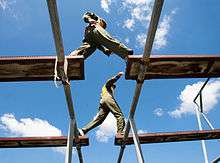
These community projects enrich local knowledge and encourage good citizenship, usually a cadet can contribute to his/her community by charity collection, public parades, assisting local services and helping at public events. This involvement within the community is important for improving confidence and social skills.
Duke of Edinburgh's Award
The Duke of Edinburgh's Award is a voluntary, non-competitive programme of practical, cultural and adventurous activities for young people aged 14–25 (year 8, if you're a cadet). A young person can undertake a DofE programme at three levels, Bronze, Silver and Gold. Each have differing criteria for entry and the level of commitment necessary to gain each award.[22] Cadets who meet the age criteria can become DofE participants and work towards their own DofE Award.
Cadets are often encouraged to achieve the Bronze, Silver and Gold awards as they progress through their cadet careers. Lots of cadet force activities can count towards each level of a participants' DofE programme and very often gets them recognition for developing skills and giving to their communities. The DofE is widely recognised by employers as it helps demonstrate that young people who hold a Duke of Edinburgh's are keen to take on new challenges, have a higher level of self-confidence than their counterparts and have leadership qualities with the added experience of teamwork.
Many detachments hold charity events, and participate in various activities such as tree planting, or carrying their standards at a Remembrance Parade in their local area.
Leadership training
Leadership training is an important part of the ACF training programme, with training available at higher levels too. Most areas run NCO courses, designed to help newly promoted NCOs to perform their duties well, or to train those eligible for promotion. There are also a number of courses run centrally by the ACF. This includes the Junior Cadet Instructors Cadre (run locally at a county level) and the Senior Cadet Instructors Course which is run at a Brigade level by Cadet Training Teams.
Master Cadet Course
The Master Cadet Course was introduced in 1989 to advance to the leadership, instructional and administrative abilities of post 4-star cadets.[23] It is held at Cadet Training Centre Frimley Park in Surrey. Passing the course makes the candidate eligible to be appointed as a Master Cadet.[23]
The following criteria must be met to be eligible for the course:[23]
- Aged 16 1/2 years old or older
- Hold the rank of sergeant or above
- Have passed fieldcraft as a progressive subject at 4-star level
- Have passed the Senior Cadet Instructors' Cadre[24]
Cadet Leadership Courses
The Aim of the Cadet Leadership Courses (CLC) is: To develop cadets' initiative and self-reliance and to exercise them in the problems of practical leadership.[25]
The course is open to members of all the Cadet Forces (SCC, ACF, ATC and CCF) providing they are over 16 and have passed their APC 3 star or equivalent. Each Course has 120 places and is focused on leadership training and assessment, which is developed through a variety of activities including:
- Minor Tactics
- Watermanship Training
- Command Tasks
- Sport
- Skill-at-Arms
- Endurance Training
The Courses take place at both the Cadet Training Centre, Frimley Park, or at Nesscliffe Training Area, Shropshire, England.
Uniform
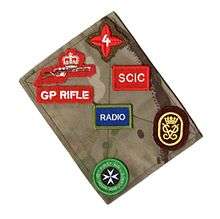
All Cadets and CFAVs are issued with Personal Clothing System Combat Uniform (PCS-CU) in Multi-Terrain Pattern (MTP). Cadets are scaled to receive the following:[26]
- Headdress (depends on regimental affiliation) - Beret, Tam o' Shanter, Glengarry or Caubeen
- Two PCS Lightweight Jackets
- Two pairs of PCS trousers
- PCS Windproof Smock
- Thermal Undershirt
- Two PCS T-shirts
- Working Belt
Some counties may charge a small deposit for uniform that is refundable on its return. All CFAVs must have "ACF" visible at all times on their uniform and cadets wear rank slides titled "CADET".[26] Boots must be purchased by the cadet or their parents if not supplied.
The ACF has its own stable belt which can be worn by cadets and instructors, but they can also wear the stable belt of their affiliated regiment/corps. Stable belts can be worn by cadets of any rank but many counties impose local requirements such as star level or rank. They may be issued at the expense of the detachment or company but are usually a private purchase item.
Ranks
Ranks in the ACF follow the pattern of those in the British Army.
Cadet ranks
As well as learning new skills by working through the APC syllabus, experienced cadets can be awarded a rank. As the Army allows its soldiers to take on responsibility and leadership as Non-commissioned Officers or NCOs, so too does the ACF.
| Insignia |  | 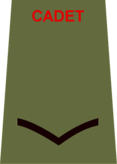 |  | 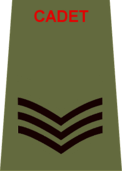 | 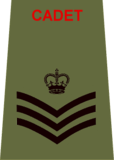 |  | 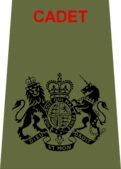 |
|---|---|---|---|---|---|---|---|
| Rank | Cadet | Cadet Lance Corporal | Cadet Corporal | Cadet Sergeant | Cadet Staff/Colour Sergeant | Cadet Sergeant Major/Company Sergeant Major | Cadet Regimental Sergeant Major |
Cadet NCOs wear the issued cadet rank slides, pictured above.[26] The titles of some ranks may vary as cadet detachments are affiliated to Army regiments and adopt their terminology. There is usually only one Cadet RSM per county.
Although promotion is based on merit rather than progression through the APC syllabus, the following criteria must be met before a cadet is eligible for promotion:[27]
- Cadet Lance Corporal - Passed APC 1 Star
- Cadet Corporal - Passed APC 2 Star
- Cadet Sergeant - Passed APC 3 Star
- Cadet Staff/Colour Sergeant - Passed APC 3 Star and got a recommendation from the commandant of the county
- Cadet Sergeant Major/Company Sergeant Major - Passed APC 4 Star
- Cadet Regimental Sergeant Major - Master Cadet[28]
In some instances, cadets that do not meet the requirements for these ranks can be promoted with the agreement of the ACF Cadet Commandant.[27]
CFAV ranks
The adults who are employed to help run the ACF are collectively known as Cadet Force Adult Volunteers(CFAVs). CFAVs wear the badges of rank as worn by Army NCOs [26] with the addition of the letters ACF under the badge.
| Insignia The letters ACF must be displayed in combination with the badge |
 | 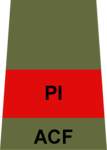 |  | 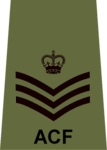 |  |  |
|---|---|---|---|---|---|---|
| Rank | Civilian Assistant | Probationary Instructor (PI) | Sergeant Instructor (SI) | Colour Sergeant/Staff Sergeant Instructor (SSI) | Sergeant Major Instructor (SMI) | Regimental Sergeant Major Instructor (RSMI) |
See also
Other elements of the Community Cadet Forces
Other MoD sponsored cadet forces
Related articles
References
- 1 2 3 "Army Cadet Force yearly review 2009". Archived from the original on 30 April 2009. Retrieved 2009-05-24.
- 1 2 3 "UK reserve forces and cadets strengths: 2015". GOV.UK. Ministry of Defence. Retrieved 18 June 2015.
- ↑ Charity Commission "THE ARMY CADET FORCE ASSOCIATION"
- ↑ "Powys Army Cadet Force History".
- ↑ Full list of NCVYS members Archived May 12, 2013, at the Wayback Machine.
- ↑ MoD(A) website. "MoD History of the Army Cadet Force (ACF)". Archived from the original on 16 October 2008. Retrieved 2008-10-10.
- ↑ "Adult Leadership and Management Course". Retrieved 2 March 2014.
- ↑ "KGVI Leadership Course". Archived from the original on 23 April 2014. Retrieved 2 March 2014.
- ↑ "army.mod.uk".
- ↑ "ACF Basic Training Syllabus and Tests" (PDF). Retrieved 2010-04-13.
- 1 2 "ACF One Star Training Syllabus and Tests" (PDF). Retrieved 2008-10-10.
- ↑ "ACF Two Star Training Syllabus and Tests" (PDF). Retrieved 2008-10-10.
- ↑ "ACF Three Star Training Syllabus and Tests)" (PDF). Retrieved 2008-10-10.
- ↑ "Foot Drill in the Army Cadets". Retrieved 2010-04-07.
- ↑ "Fieldcraft in the Army Cadets". Retrieved 2010-04-07.
- ↑ "Skill-at-Arms in the Army Cadets". Retrieved 2010-04-07.
- ↑ "L98A2 Weapon Handling Test". Retrieved 2010-06-22.
- ↑ "Shooting in the Cadet Forces". Retrieved 2013-02-17.
- ↑ MoD(A) website. "ACF Activities". Archived from the original on 16 September 2008. Retrieved 2008-10-10.
- ↑ http://www.bhf.org.uk/get_involved/other_ways_to_get_involved/heartstart_uk_training.aspx
- ↑ http://www.sja.org.uk/sja/training-courses/courses-for-the-general-public/activity-first-aid.aspx
- ↑ DoE website. "The Duke of Edinburgh's Award". Archived from the original on 9 October 2008. Retrieved 2008-10-10.
- 1 2 3 "Master Cadet Course page at armycadet.com". armycadets.com. Retrieved 2012-01-17.
- ↑ "SCIC Course page at armycadet.com". armycadets.com. Retrieved 2012-01-17.
- ↑ http://www.armycadetforce.net/courses-for-cadets/army-courses/142-cadet-leadership-course-frimley.html
- 1 2 3 4 Army Dress Regulations (All Ranks), Part 08 "Dress Regulations for Combined Cadet Force (Army Sections) and the Army Cadet Force", Ministry of Defence, April 2013
- 1 2 AC 14233 The Army Cadet Force Manual (2005 Edition), Paragraph 6.012
- ↑ "Cadet Ranks". Retrieved 2 March 2014.
External links
| Wikimedia Commons has media related to Army Cadet Force. |
- Army Cadet Force official website (armycadets.com)
